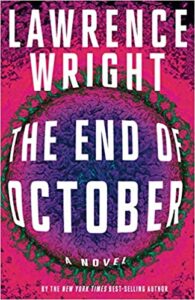According to the Art:
This novel, written immediately before the current pandemic, offers correspondences between a literary account with fictional analogs to figures responding to the current pandemic, adding a measure of foresight to the many previous literary depictions of human responses to plagues.
Background:
The End of October, by Lawrence Wright, released in April, 2020, is a novel involving a viral pandemic that is initially thought to originate “at the Kongoli Number Two Camp in West Java.” (p. 3). But this is not a novel about a virus that escaped as the result of favorable biological and environmental conditions. It’s a thriller about a pandemic set loose on the world as an act of biowarfare.
Wright imagines the reactions to a lethal viral pandemic that could be expected from scientists, government leaders, political figures, and societal institutions. Much of what he depicts mirrors what has been seen during the 2020 Covid pandemic. Other novels involving infectious plagues have done the same, even some written hundreds of years ago. The correspondences of those earlier works to the current pandemic draw from historical sources and understandings of human nature (or human folly). Wright, however, wrote this novel close enough in time to the current pandemic that he could draw on his knowledge of the actual people in scientific, governmental, political, and institutional spheres who would respond to the current pandemic, and he could account for contemporary sociological contexts and cultural phenomena of the time having been a journalist with decades of focus on these factors.
Here I take excerpts from the book and compare them to corresponding statements, quotes, or reports about the 2020 Covid pandemic. I focus on pairings that draw from parallels between fictional characters in the book and people involved in the current pandemic, and between scenarios in the book presents and situations the current pandemic presents.
In the following pairings, an excerpt from the book is first, followed by an excerpt from various sources reporting on the 2020 coronavirus pandemic.
The version of The End of October serving as the source for the quotes is this one:
The End of October
Lawrence Wright
Alfred A. Knopf
New York
2020
380 pages
Pairings:
Me, worry?
The idea that Kongoli would simply flame out was in all likelihood a wishful fantasy. (p. 88)
———————————-
President Donald Trump still believes that coronavirus will ‘just disappear’ at some point, even as the US creeps toward 130,000 confirmed deaths from the virus and cases continue to rise at an alarming rate. ‘We’re heading back in a very strong fashion, with a V. And I think we’re going to be very good with the coronavirus. I think at some point that’s going to sort of just disappear, I hope,’ Trump said. (Business Insider, July 1, 2020)
The crown prince laughed. ‘But this is the flu!’ he said. ‘We have the flu every year! We all get the flu, even the royal family!’ (p. 116)
———————————-
‘This is a flu. This is like a flu.’ Trump at a Feb 26, 2020 news conference (Barron’s, March 3, 2020)
The government was constantly trying to reassure citizens that everything possible was being done, but the reassuring lies only gave credence to the most flagrant conspiracy theories. (p. 195)
———————————-
‘I’ve [Trump] always known this is a real—this is a pandemic. I felt it was a pandemic long before it was called a pandemic … I’ve always viewed it as very serious.’ (The Atlantic, July 13, 2020)
Rumors and imagined conspiracies shoved real news aside. As a result the country was a cauldron of emotions—paranoia chief among them. (p. 329)
———————————-
We followed and examined COVID-19–related rumors, stigma, and conspiracy theories circulating on online platforms, including fact-checking agency websites, Facebook, Twitter, and online newspapers…between December 31, 2019 and April 5, 2020…We identified 2,311 reports of rumors, stigma, and conspiracy theories in 25 languages from 87 countries. (American Journal of Tropical Medicine and Hygiene, first online: August 10, 2020)
Hey buddy, have you got a…
Mayor Jackson demanded additional medical supplies from the nation’s emergency storehouse. (p. 140)
———————————-
The mayor [DeBlasio, NYC]…asked the federal government for three million N-95 masks, 50 million surgical masks, 15,000 ventilators and 25 million pairs of gloves, gowns along with other protective gear. (AMNY, March 23, 2020)
We just haven’t ever been given the resources and personnel to carry them out. Like ventilators. We figure that maybe 30 percent of hospital patients reporting severe influenza symptoms will need to be ventilated. Right not we can accommodate about one percent of patients who require them… (p. 147)
———————————-
He said New York has more than 25,000 coronavirus cases and his state needs 30,000 more ventilators on top of the 7,000 it has. Cuomo wants all of what he called a current federal stockpile of 20,000 ventilators to brace for the coming ‘apex’ in cases in New York, which he says will arrive as soon as 14 days. ‘We need the federal help, and we need the federal help now,’ Cuomo said. (KTLA, March 24, 2020)
Provisional hospital space was created in the Wells Fargo Center, where the 76ers played. (p. 141)
———————————-
The 10,000-seat basketball and events arena at Temple University [Philadelphia], the Liacouras Center, is fully stocked with 180 beds, oxygen lines, dedicated ambulances, and adequate personal protection equipment. (Philadelphia Tribune, April 10, 2020]
We’ve got this…
The vice president was a former governor and radio host known for his tough demeanor. The president had made him the official point person for the pandemic, and recently he had begun attending the Deputies Committee meetings. (pp. 147-148)
———————————-
At a press conference Wednesday afternoon, President Donald Trump announced Vice President Mike Pence will oversee the administration’s coronavirus response. Pence ‘has got a certain talent for this,’ Trump said. (Mother Jones, February 26, 2020)
Even if we had a vaccine, who gets the shot? It takes months to ramp up production…and let’s say we get ten thousand doses the first week, and a hundred thousand the week after, and five hundred thousand the next week, and so on. It’ll still take months to scale up to the point where we’ll have enough material to create some kind of herd immunity. (p. 148)
———————————-
No matter how well-prepared we are, there won’t immediately be enough coronavirus vaccine to immunize all Americans. Choices will have to be made about who goes to the front of the line. (USA Today, May 18, 2020)
Don’t look now…
‘What went wrong? We had this licked.’ [vice president]
‘As you may remember, we talked about this last week when you suggested that everyone go back to work.’ [Public Health Service official]. (p. 182)
———————————-
Vice President Mike Pence on Thursday vowed that the Trump administration would “keep opening up America” despite a recent surge in coronavirus cases. (CNBC, July 2, 2020)
The president had been almost entirely absent in the debate about how to deal with the contagion, except to blame the opposing party for ignoring public health needs before he took office. (p. 184)
———————————-
As the task force held its first televised press conference in two months, Trump was notably absent. (Time, June 26, 2020)
It had never been so clear what herd animals humans were. Almost overnight, they had disappeared from the subways and buses and trains. And, almost overnight, they returned, though in smaller numbers. The worst was over, people told themselves. Time to pick up where we left it. (p. 176)
———————————-
After bottoming out at on April 13 at nearly 366,000, weekday ridership has rebounded more than 150 percent, to nearly 950,000 people. (NY1, June 20, 2020)
Here, try this, trust us…
…the vice president continued. ‘I want you to report to the White House tonight and bring a dose of that stuff for the president…and his family members.’ (p. 184)
———————————-
‘I’m [Trump] taking it, hydroxychloroquine. Right now, yeah. Couple of weeks ago, I started taking it. Cause I think it’s good, I’ve heard a lot of good stories.’ (CNBC, May 18, 2020)
…we are in trials with three different vaccines. We hope to have one of them ready and in production before the virus returns this fall. (p. 305)
———————————-
Operation Warp Speed (OWS) aims to deliver 300 million doses of a safe, effective vaccine for COVID-19 by January 2021, as part of a broader strategy to accelerate the development, manufacturing, and distribution of COVID-19 vaccines, therapeutics, and diagnostics. (HHS.gov, June 16, 2020)
Bring out your dead…
Mortuaries had shut down because of fear of infection and the dearth of caskets. The bodies arrived in rental trucks. (p. 202)
———————————-
The U.S. Federal Emergency Management Agency is sending an additional 14 refrigerated mortuary trucks to Texas as the state grapples with a rising number of coronavirus-related deaths. (The Statesman, July 17, 2020)
Comment:
Plagues of all sorts, especially infectious, have been a concern of the arts across the millennia. They share many attributes across time, the human reactions to them in particular. For that reason, finding correspondence between novels from the past and the experiences of the 2020 coronavirus pandemic is easy (and deflating). I have looked at two in particular before, one being Sinclair Lewis’ novel, Arrowsmith here, and the other, Alessandro Manzoni’s novel, The Betrothed here.
This novel, written immediately before the current pandemic, offers correspondences between a literary account with fictional analogs to figures responding to the current pandemic. In doing so, Wright has provided an added measure of foresight to the many previous literary depictions of human responses to plagues.
Note: Pandemic splatter text available under the Creative Commons CC0 1.0 Universal Public Domain.



